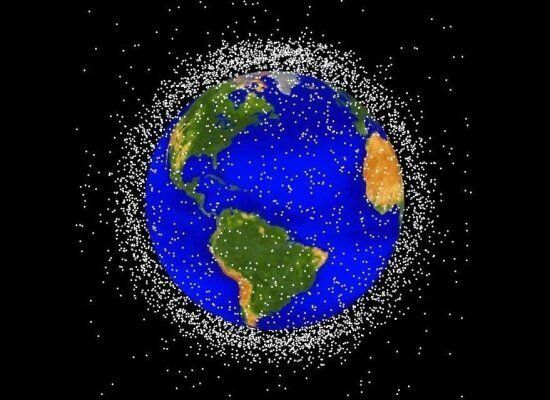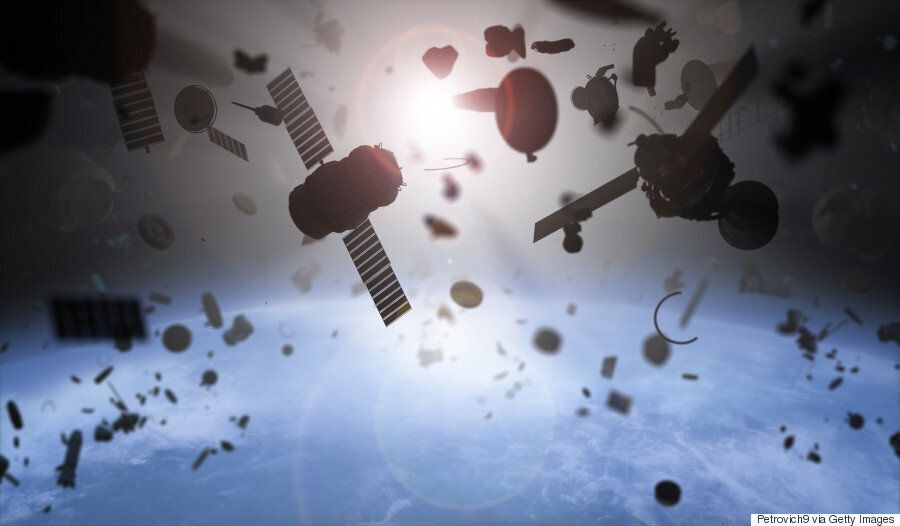
You know that opening shot in Gravity, the mind-blowing continuous one when George Clooney and Sandra Bullock are repairing the Hubble telescope when suddenly tiny bits of a smashed Russian satellite start wreaking havoc?
All that 3-D death and destruction wasn't pulled out of no air.
How about War Games, the 1980s classic where Matthew Broderick's hacker nearly starts World War III by accidentally making the Soviets think they are under attack?
According to experts, these nightmare scenarios could very well come true.
"[Space debris] may provoke political or even armed conflict between space-faring nations [because] the owner of the impacted and destroyed satellite can hardly quickly determine the real cause of the accident," Russian scientist Vitaly Adushkinis warns in a study to be published in the journal "Acta Astronautica."
He's not alone.
Theresa Hitchens, director of the UN Institute for Disarmament Research, also warned IO9 in 2014 about the security threat of space junk.
"The owner government of the satellite might conclude that it was a deliberate act," she said, adding that anti-satellite weapons, even if intended to destroy space junk, increase the danger. "It would be a very unstable situation, prone to miscalculation and crisis escalation.... We don't need any more fuel for possible flames."
Our planet is surrounded by an "invisible landfill," Natalie Panek told The Huffington Post Canada backstage at a TedX Toronto event where she discussed the issue. Panek is a 29-year-old Calgary native based in Toronto, where she works for space robotics firm MDA, maker of the famed Canadarm.
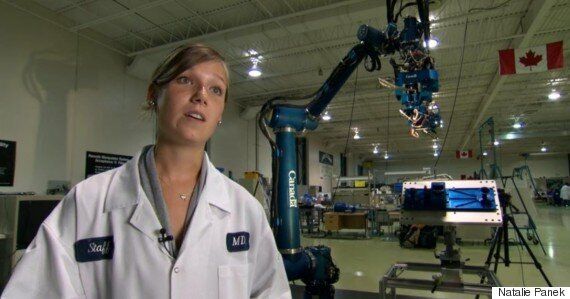
Natalie Panek works for space robotics firm MDA.
Space junk is mostly made up mostly of dead satellites, depleted rockets and missile shrapnel as well as the smaller results of collisions or explosions. In 2009, for instance, a defunct Russian satellite smashed into a working U.S. one, creating 2,200 pieces of debris. Two years earlier, the Chinese shot one of their own down in anti-satellite missile test, creating another 3,300 bits of junk (and risking a new arms race).
This problem has been growing since the day the Soviets launched Sputnik I back in 1957, but little has been done about it "because the orbital environment is sight unseen," Panek says, "while we can see litter in our everyday environment."
But out of sight won't be out of mind if our satellites start going down, threatening dependent technology like telecommunication and navigation as well as the global financial system and the military. (The BBC lays out the doomsday scenario here.) The International Space Station is in danger, too, and had to move four times last year alone to avoid collisions with space junk.
NASA is tracking more than 21,000 pieces of debris orbiting earth larger than 10 centimetres and estimates there are an additional 500,000 between one centimetre and 10 centimetres, and maybe millions smaller than one centimetre.
So, a lot.
This debris travels at an average of 28,000 km/h, although it can be double that, and, Wired magazine reports, "mere flecks of paint (of which there are many) travel with sufficient force to sever electrical wires, dent spacecraft, and kill astronauts." It adds that there are about 3,000 tons of orbiting debris all told — or the equivalent of "roughly 15 blue whales, 600 elephants, or 1,500 cars."
Tracking of the bigger debris is currently accurate enough that rockets can get through it, but Panek points out that Elon Musk of SpaceX and Tesla wants to create a space-based internet that requires "a huge constellation to satellites. If we get to that, 10 or 15 years down the road then it could get to be too much congestion."
And then there's the Kessler Syndrome dramatized in that "Gravity" scene.
"They have a syndrome where if you have a collision," she said, "that creates smaller pieces of debris and causes this cascade of never-ending debris and it's a fact that you can't stop."
'Critical density'
Donald Kessler, a former NASA scientist, has actually come out of retirement to help deal with the issue, which, he told Marketplace.com, has reached "critical density" (although it would't happen as rapidly as in the film).
So what can be done?
There are a few ideas in the works, ranging from a laser cannon (!) on the International Space Station to a Pac-Man-inspired Swiss spacecraft called the CleanSpace One that swallows space junk and then descends to burn up in Earth's atmosphere.
The Japanese are currently testing a space net that they hope to have in action by 2019, and the European Space Agency has its own net system, e.DeOrbit, aiming for a 2021 launch.
While those focus on getting rid of current space junk, Panek says MDA has been working on a solution to its creation in the future.
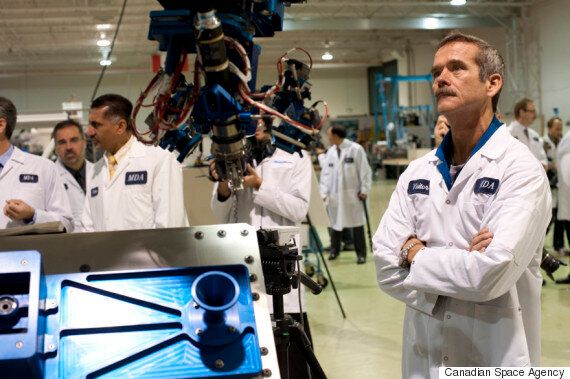
Former astronaut Chris Hadfield was the first Canadian to operate the Canadarm in orbit.
Dubbed On-Orbit Service and in collaboration with the Canadian Space Agency, the idea is to extend the lifespan of satellites, which can hold only so much propellant at launch and which can require repairs because of either unforeseen technical problems or simply age. Once one of the 1,100+ active satellites stops working, it becomes space debris like the 2,500 or so dead ones currently orbiting the planet.
The plan is to use the Next-Generation Small Canadarm (NCG) to do robotic servicing to refuel and repair broken-down satellites.
The prototype builds off the "robotic handyman" capabilities of its larger Canadian cousin, Dextre, currently attached to the ISS.
According to the Canadian Space Agency, "The robot can perform a variety of intricate tasks including: removing and installing components, removing the protective blankets that cover satellites; cutting wires; opening and closing fuel valves, and transferring propellant between servicer and client spacecraft."
The NGC is currently at technology readiness Level Four — Level One is concept and Nine is space-worthy.
On top of reducing future space junk, satellites servicing could potentially also save billions of dollars in construction and launch costs. Yet the business case been difficult to build.
MDA had been working on a Space Infrastructure Servicing (SIS) vehicle that would fly the next-gen Canadarm into space and stay there for seven years performing repair and refuelling missions like an orbiting garage. Those plans have been on hold since their European satellite corporation Intelsat cancelled its "anchor tenant" contract in 2012.
"Canada's space robotics technologies are well positioned to contribute to potential satellite servicing missions," says Gilles Leclerc, CSA's director general, space exploration. "However, there are no missions for the technology yet, so we do not have a projected timeframe for when a future generation of the technology could fly in space."
He said, however, that the CSA is not waiting around for the SIS. "At this point in time, Canada is also involved in discussions with its international partners on the subject. Canada's space industry is also currently involved in a number of studies led by the European Space Agency related to deorbiting the satellite Envisat."
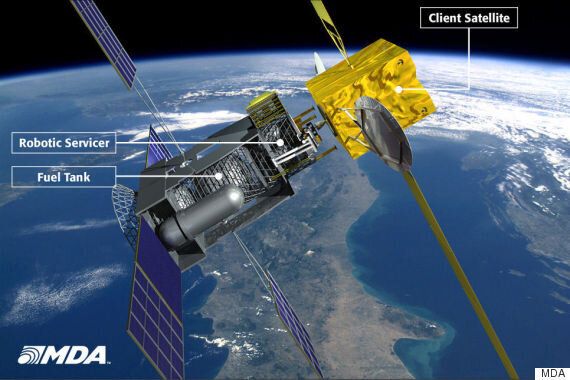
While Panek can't comment specifically on the program, she says that "satellite servicing programs like SIS are incredibly important in a long-term solution to space debris.... Satellite servicing has to become a normal aspect of our space infrastructure once we overcome near-term challenges like regulations and policy, in addition to the technology required."
Beyond economic and technical feasibility lies the additional challenge of actually getting countries to go along with such a program.
"A lot of international space law is governed by the United Nations. They have guidelines and recommendations on how to design satellites so that you don't leave debris. But nothing is enforced," she said.
"There's no maritime law in space that you can go salvage or service another country's satellite without their permission. So if another country has a satellite that hasn't been working for 15 years, and we wanted to go deal with it without their permission, we could get into a lot of nasty politics.
"It really will take countries' coming together [and] saying this is something that we will do as humans, as one entire entity."
While Panek started working on MDA's next-gen Canadarm when she was hired five years ago after a NASA internship, she's no longer active on that project.
"I'm actually on a Mars Rover program right now," she said, "but I really think satellite servicing is so cool that I love talking about it."
Joshua Ostroff is a senior editor for HuffPost Canada.

